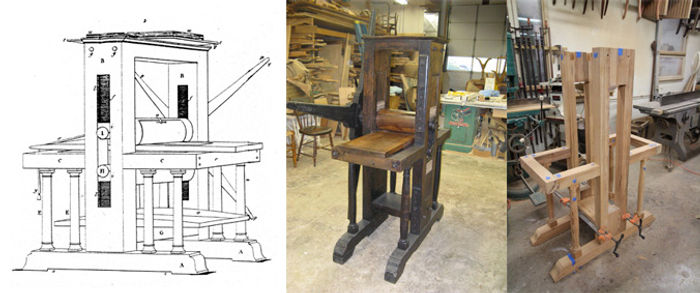
Reconstructions
Part of art technological source research is making reconstructions of historical techniques, materials, tools and apparatus. Combining research of historical recipes, materials and objects with modern practice in order to make a reconstruction is exciting and very rewarding, because of the insight it allows in primary sources (PDF, 4.1MB). Enquire about inviting me to produce reconstructions for your projects.

Reconstructions of working with a drypoint (left), burin (middle) and scorper (right).

Basics of the preparation of a black oil based relief printing ink for my presentation on historical printing inks ‘Ohne Farbe kein Druck: Gutenberg und seine Druckfarben’ for the IADM conference Johannes Gutenberg – der erste „Ingenieur“ der Drucktechnik: Neue Fragen und innovative Antworten zur Realisierung des Buchdrucks. The conference took place in the Gutenberg-Museum, Mainz (Germany) from 1–3 November 2018, find the programme here (PDF, 209KB). Find a short slide presentation on grinding ink here (PPt, 4.8MB).

Textual analysis and physical reconstructions of printmaking recipes from Ms. Fr. 640 kept in the Bibliothèque nationale de France, Paris, an anonymous sixteenthth-century recipe collection, for the Making and Knowing Project: Intersections of Craft Making and Scientific Knowing, Columbia University, New York, 2018.
The picture shows the spine of the leather bound volume that keeps the manuscript; photo by the Making and Knowing Project.
Check here for details: http://www.makingandknowing.org/?page_id=25
For a recent lecture on reconstructions see: https://vimeo.com/487139383?utm_source=Making+and+Knowing+Subscribers&utm_campaign=2527966b56-EMAIL_CAMPAIGN_Feb+2021&utm_medium=email&utm_term=0_972ef1e19f-2527966b56-108654017

Advice on the reconstruction of the pigment Frankfurt black and the physical reconstruction of an intaglio ink with this pigment, Kanazawa College of Arts, Kanazawa, Japan, January 2017; advice on the project during the period 2004–2016.
The picture shows the preparation for manually grinding an intaglio ink from reconstructed Frankfurt black. Photo by the Kanazawa College of Arts.

Advice on the reconstruction of the pigment Frankfurt black, the preparation of oil varnish, and the physical reconstruction of an intaglio ink with this pigment and oil varnish, Staatliche Akademie der bildenden Künste, Stuttgart, August 2016. Photos by the Staatliche Akademie der bildenden Künste.

Research on and reconstructions of Hercules Segers's printmaking techniques for the exhibitions: Hercules Segers, Rijksmuseum, Amsterdam, 7 October 2016–8 January 2017, and The Mysterious Landscapes of Hercules Segers, Metropolitan Museum, New York, 13 February–21 May 2017.
The picture shows on the left a detail of Segers’s Roman Ruins, a City in the Distance (HB 42, Rijksmuseum) printed from two plates in black and blue as it appears now. On the right is a digitally processed detail that gives an idea how the print may have looked like if the colours had not faded and the paper yellowed, with the sky in blue and the landscape in black (the green stains are oil blotches).
Check here for the exhibitions: https://www.rijksmuseum.nl/en/hercules-segers and https://www.metmuseum.org/exhibitions/listings/2017/hercules-segers.
Check here to see all Segers's works kept in the Rijksmuseum, Amsterdam, in high resolution with their catalogue entries: https://www.rijksmuseum.nl/en/research/collection-catalogues/works-by-hercules-segers.

Research on and reconstructions of engraving and etching techniques used by European printmakers in the first half of the 16th century for the exhibition The Renaissance of Etching. The exhibition was in the Metropolitan Museum, New York, from 23 October 2019 to 20 January 2020, after which it moved to the Albertina, Vienna, from 12 February to 10 May 2020, extended to 18 October 2020.
The eighteen impressions and enlargement in the picture show a re-drawn detail in drypoint of a Schiavone print and its wear during printing an edition. The reconstructed printing ink was ground manually, according to a recipe that was considered coming close to the original ink recipe.

The basic construction of an intaglio rolling press is relatively simple: two rollers positioned in a frame vertically above each other. However, press designs changed through the ages. Research therefore begins with gathering information on its appearance through place and time: http://woodenpress.info/RollingPresses/illustrations/illustrations.html.
For advice on the conservation and reconstruction of a French wooden rolling press of c.1800 M. Berthiaud's Nouveau manuel complet de l'imprimeur en taille douce (Paris 1837) gave detailed information and imagery of presses of the period. Information and additional advice were shared with Lessons on Liberty, Boston, Mass., in 2012–2018: http://lessonsonliberty.com/about/ (currently not available).
From left to right: image of a French rolling press in Berthiaud 1837, pl. 1; a French wooden rolling press of c.1800 formerly kept in the Paris printshop of Frélaut & Lacouriere; and the replica under construction in the workshop. Photos by Gary Gregory.

Advice on the reconstruction of an 18th-century English wooden rolling press for the exhibition William Blake: Apprentice and Master, Ashmolean Museum, Oxford, 4 December 2014–1 March 2015.
From left to right: images of 18th- and early 19th-century English rolling presses; the reconstructed press in the workshop; and the press in the exhibition. Photos by Michael Phillips.
Check here for details: https://www.ashmolean.org/event/william-blake-apprentice-and-master (not available anymore).

Advice and design for the reconstruction of a 17th-century Dutch wooden rolling press, the interior of a 17th-century printshop and contemporaneous tools for the Rembrandt House Museum, Amsterdam. Additional training of the staff in press maintenance and printing parchment.
From left to right: an ‘exploded’ view of the rolling press in Abraham Bosse’s Traicté des manieres de graver en taille douce sur l’airin (Paris 1645), pl. 11; the new press under construction in the workshop; and the reconstruction in use. The press was installed in the printshop of the Rembrandt House Museum in September 2003 and has been used for printing demonstrations on a daily basis since. Photos by Yuriko Miyoshi and the Rembrandt House Museum.
Check here for details: https://www.rembrandthuis.nl/en/bezoek/agenda-activiteiten/etching-demonstration/ (not available currently).